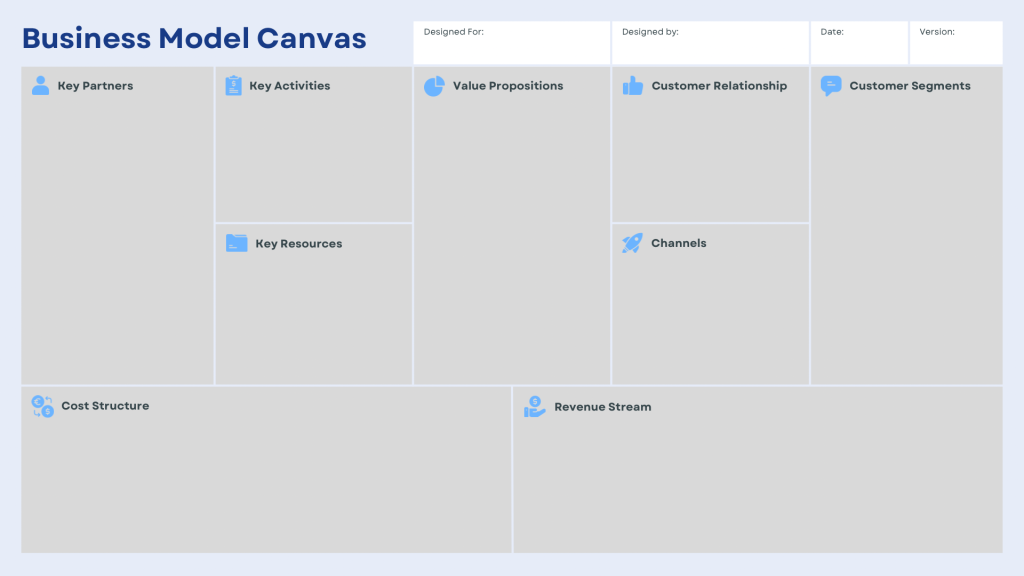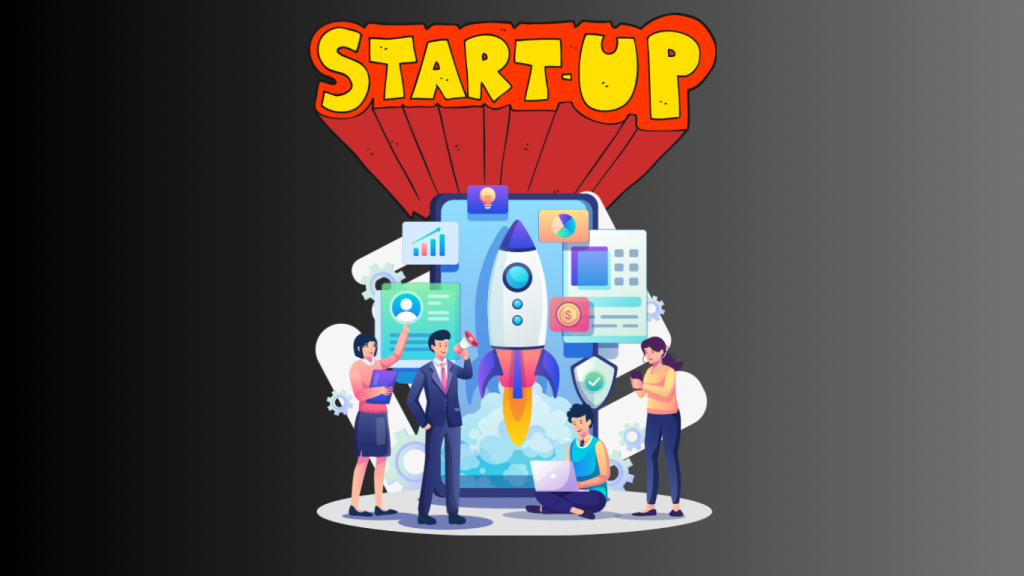Introduction
In today’s dynamic business landscape, having a solid strategy is crucial for sustainable success. The best way is to use the Business Model Canvas strategy, which offers a comprehensive framework for analyzing and developing business models. In this article, we will delve into the key components of the Business Model Canvas, explore its benefits, provide a step-by-step guide to implementation, showcase real-life examples, address common challenges, and discuss future trends in this field.

Understanding the Business Model Canvas strategy
The Business Model Canvas strategy is a visual tool that allows businesses to describe, analyze, and design their business models comprehensively. It consists of nine key components that are interlinked to create a holistic view of a business model. These components include:
- Customer Segments: Identifying the specific groups of customers a business aims to serve.
- Value Propositions: Determining the unique value and benefits a business offers to its customers.
- Channels: Identifying the various channels through which a business reaches its customers.
- Customer Relationships: Defining the types of relationships a business establishes and maintains with its customers.
- Revenue Streams: Determining the sources of revenue for a business and the pricing mechanisms.
- Key Resources: Identifying the critical resources required to operate the business.
- Key Activities: Defining the essential activities a business must undertake to deliver its value propositions.
- Key Partnerships: Establishing strategic alliances and collaborations to enhance business operations.
- Cost Structure: Analyzing the costs associated with operating the business.

Benefits of Implementing a Business Model Canvas Strategy
Implementing a Business Model Canvas strategy offers several advantages for businesses:
- Holistic View: The Business Model Canvas provides a holistic view of the entire business model, enabling businesses to identify gaps, opportunities, and areas for improvement.
- Alignment and Focus: It aligns all stakeholders by providing a shared understanding of the business model, fostering collaboration and focus towards common goals.
- Flexibility and Adaptability: The visual nature of the canvas allows businesses to iterate and adapt their strategies quickly in response to market changes.
- Innovation and Creativity: By examining each component individually, businesses can explore innovative ideas and develop creative solutions to enhance their value propositions.
- Identifying New Revenue Streams: The canvas helps businesses identify untapped revenue opportunities and diversify their income sources.

Step-by-Step Guide to Developing a Business Model Canvas Strategy
Let’s explore a step-by-step guide to developing an effective Business Model Canvas strategy:
1. Identifying the Customer Segments
- Define the specific target customer groups based on their characteristics, needs, and preferences.
- Conduct market research and analyze customer behavior to gain insights into their preferences and expectations.
- Segment customers based on demographics, psychographics, or other relevant factors.
2. Defining Value Propositions
- Determine the unique value and benefits your business offers to address the specific needs of each customer segment.
- Highlight the competitive advantages that set your business apart from competitors.
- Craft compelling value propositions that clearly communicate the benefits to customers.
3. Determining Channels for Customer Reach
- Identify the most effective channels to reach and engage with your target customers.
- Explore various distribution channels such as online platforms, physical stores, or direct sales.
- Optimize the customer journey by selecting channels that align with customer preferences.
4. Establishing Customer Relationships
- Define the types of relationships your business aims to establish with customers.
- Consider factors such as personalization, self-service, or community-building.
- Develop strategies to nurture long-term relationships and enhance customer loyalty.
To provide a more comprehensive understanding of the step-by-step guide, refer to the following table:
| Step | Description | Examples/Tools |
|---|---|---|
| 1. | Identifying the Customer Segments | – Market research<br>- Surveys<br>- Customer interviews |
| 2. | Defining Value Propositions | – Unique selling propositions (USPs)<br>- Value proposition canvas |
| 3. | Determining Channels for Customer Reach | – Social media platforms<br>- E-commerce platforms<br>- Physical retail stores |
| 4. | Establishing Customer Relationships | – CRM software<br>- Loyalty programs<br>- Personalized communication |
5. Analyzing Revenue Streams
- Evaluate the different sources of revenue for your business.
- Consider pricing strategies, such as one-time payments, subscriptions, or freemium models.
- Identify opportunities to increase revenue through upselling, cross-selling, or complementary offerings.
6. Identifying Key Resources
- Identify the critical resources required to deliver your value propositions.
- These resources can include physical assets, intellectual property, human resources, or strategic partnerships.
- Determine how to acquire, manage, and optimize these resources effectively.
7. Managing Key Activities
- Determine the key activities necessary to execute your business model effectively.
- These activities may include production, marketing, distribution, or customer support.
- Optimize processes and workflows to streamline operations and improve efficiency.
8. Evaluating Key Partnerships
- Identify strategic partnerships and collaborations that can enhance your business model.
- Consider suppliers, distributors, technology providers, or other complementary businesses.
- Establish mutually beneficial relationships to leverage shared resources and expertise.
9. Assessing Cost Structure
- Analyze the cost structure of your business, including fixed costs, variable costs, and economies of scale.
- Identify opportunities for cost optimization, such as process improvements or outsourcing.
- Maintain a balance between cost control and investment in key resources and activities.
To provide further clarity on the steps involved, here’s an additional table explaining them:
| Step | Description | Examples/Tools |
|---|---|---|
| 5. | Analyzing Revenue Streams | – Pricing models<br>- Revenue projections<br>- Upselling/cross-selling strategies |
| 6. | Identifying Key Resources | – Physical assets<br>- Intellectual property<br>- Human resources |
| 7. | Managing Key Activities | – Production processes<br>- Marketing campaigns<br>- Customer support systems |
| 8. | Evaluating Key Partnerships | – Strategic alliances<br>- Supplier agreements<br>- Joint ventures |
| 9. | Assessing Cost Structure | – Cost analysis<br>- Budgeting<br>- Cost optimization strategies |
Successful Business Model Canvas Strategies in Action
To illustrate the practical application of the Business Model Canvas strategy, let’s examine two real-life examples:
Company A: This tech startup used the Business Model Canvas to redefine its value proposition, targeting a niche market segment. By leveraging its unique technological capabilities, the company disrupted the industry and achieved rapid growth.
Company B: This established retail brand implemented the Business Model Canvas to explore new revenue streams and expand its online presence. By strategically partnering with e-commerce platforms and optimizing their customer relationships, the company experienced significant revenue growth.
Key Considerations and Challenges in Implementing the Business Model Canvas Strategy
While the Business Model Canvas strategy offers numerous benefits, it’s essential to consider potential challenges during implementation:
- Resistance to Change: Some stakeholders may resist adopting a new strategic framework, requiring effective change management.
- Limited Data Availability: Gathering accurate data for market research and customer insights can be challenging, requiring innovative approaches.
- Complexity: Balancing the various components of the canvas and ensuring alignment can be complex, requiring careful analysis and coordination.
Future Trends and Innovations in Business Model Canvas Strategy
The field of business model canvas strategy continues to evolve, driven by emerging trends and innovations. Some key areas to watch out for include:
- Digital Transformation: Increasing digitization is reshaping business models, necessitating adaptations and new approaches to the canvas strategy.
- Sustainable Business Models: The focus on sustainability and social impact is driving the emergence of new business models centered around environmental and social responsibility.
- Technological Advancements: Advancements in technologies such as artificial intelligence, blockchain, and the Internet of Things are influencing the way businesses design their models.
Frequently Asked Questions (FAQs)
Q1: What is the Business Model Canvas? A:The Business Model Canvas is a visual framework that assists firms in completely describing, analyzing, and designing their business models.
Q2: How does the Business Model Canvas differ from a traditional business plan? A:The Business Model Canvas, as opposed to a standard business plan, focuses on a visual depiction that highlights critical components and their interdependencies.
Q3: How can the Business Model Canvas strategy benefit my business? A:Putting a Business Model into Action A holistic perspective of the business model, increased alignment, flexibility, and the ability to uncover new revenue streams are all advantages of the canvas method.
Q4: Can the Business Model Canvas be used for startups and established businesses alike? A:Yes, the Business Model Canvas may assist both startups and existing firms in understanding, innovating, and optimizing their business models.

Conclusion
Businesses can use the Business Model Canvas strategy to assess, innovate, and optimize their business models. Businesses can acquire a competitive advantage and create long-term success by knowing the major components, benefits, and step-by-step implementation method. Adopt the Business Model Canvas concept, customize it for your specific situation, and discover new chances for growth and innovation in your market.
In addition to the power of the Business Model Canvas strategy, it is crucial to master the art of the pitch. A compelling pitch that effectively communicates your business model and value proposition can open doors to partnerships, investments, and growth opportunities. So, combine the strength of the Business Model Canvas with an impactful pitch to maximize your chances of success.


